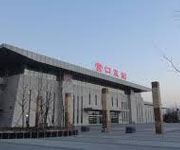
The city is home to the basketball club Liaoning Flying Leopards of the Chinese Basketball Association. The club brought forth several players of China's national basketball team. It plays its home games at the Benxi Gymnasium.
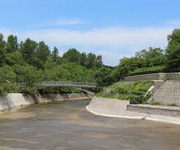
Changchun is the capital and largest city of Jilin province, located in the northeast of the People's Republic of China, in the center of the Songliao Plain. It is administered as a sub-provincial city including counties and county-level cities, with a population of 7,674,439 at the 2010 census under its jurisdiction. The city's built-up (or metro) area, including 5 districts and 4 development areas, had a population of 3,815,270 in 2010 as Shuangyang district is not conurbated yet. The name, which means "Long Spring", originated from the Jurchen language. Known as China's Automobile City, Changchun is an important industrial base with a particular focus on the automotive sector. Apart from this industrial aspect, Changchun is also one of four "National Garden Cities" awarded by the Ministry of Construction of P.R. China in 2001 due to its high urban greening rate.

Shenyang, formerly romanized as Mukden, is the capital and largest city of Liaoning Province, as well as the largest city in Northeast China by urban population. According to the 2010 census, the city's urban area has 6,255,921 inhabitants, while the total population of the Shenyang municipality is up to 8,106,171. Currently holding sub-provincial administrative status, the city was once known as Shengjing or Fengtian Prefecture. In the 17th century, Shenyang was conquered by the Manchu people and briefly used as the capital of the Qing dynasty. Along with its nearby cities, Shenyang is an important industrial centre in China, and serves as the transportation and commercial hub of China's northeast—particularly with Japan, Russia, and Korea.[9] A titan of heavy industry since the 1930s, and the spearhead of the Chinese central government's Northeast Area Revitalization Plan, the city has been diversifying its industry and now has a solid industrial foundation, a good land and air transport network, abundant natural resources, and a skilled workforce.
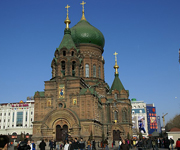
Harbin (help·info) is the capital and largest city of Heilongjiang province, People's Republic of China. Holding sub-provincial administrative status, Harbin has direct jurisdiction over 9 metropolitan districts, 2 county-level cities and 7 counties. Harbin is the eighth most populous Chinese city and the most populous city in Northeast China. According to the 2010 census, the built-up area made of 7 out of 9 urban districts (all but Shuangcheng and Acheng not urbanized yet) had 5,282,093 inhabitants, while the total population of the sub-provincial city was up to 10,635,971. Harbin serves as a key political, economic, scientific, cultural and communications hub in Northeast China, as well as an important industrial base of the nation.
Jilin (Chinese: 吉林; pinyin: Jílín; former official name: Kirin) is one of the three provinces of Northeast China. Jilin borders North Korea and Russia to the east, Heilongjiang to the north, Liaoning to the south, and Inner Mongolia to the west. In ancient times, Jilin was inhabited by various peoples, notably the Xianbei, Koreans, the Mohe and the Wùjí (勿吉). Various Korean kingdoms, including the Buyeo, Goguryeo and Balhae, were established in this area. The region then fell successively under the domination of the Xiongnu, Xianbei state, Khitan Liao Dynasty, the Jurchen Jin Dynasty, and the Mongol Yuan Dynasty. During the Qing Dynasty, much of the area was under the control of the General of Jilin, whose area of control extended to the Sea of Japan to encompass much of what is Russia's Primorsky Krai today. Immigration of Han Chinese was strictly controlled.
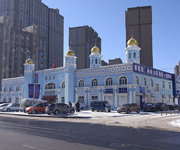
Jiamusi (Manchu: Giyamusi, Chinese: 佳木斯; pinyin: Jiāmùsī; formerly Kiamusze) is a prefecture-level city in eastern Heilongjiang province, People's Republic of China. Located along the middle and lower reaches of the Songhua River, it faces Russia's Khabarovsk Krai across the Ussuri River and the Amur River. In 2007 Jiamusi had a GDP of RMB 34.1 billion with a 14.3% growth rate. Its population was 2,552,097 at the 2010 census whom 881,711 lived in the built up area made of 4 urban districts.

Mudanjiang (Chinese: 牡丹江; pinyin: Mǔdānjiāng; Manchu: Mudan bira) is a prefecture-level city in southernmost Heilongjiang province, People's Republic of China. It was called Botankou when it was under Japanese occupation. It serves as a regional communications hub with a railway junction and an international airport connecting with several major Chinese cities as well as Seoul, Korea. Mudanjiang is also an important border city, located only 248 km (154 mi) from Vladivostok, Russia. In 2011 Mudanjiang had a GDP of RMB 93.48 billion with a 15.1% growth rate. Its population is 2,798,723 at the 2010 census whom 965,154 live in the built-up (or metro) area made of 4 urban districts. In 2007, the city is named China's top ten livable cities by Chinese Cities Brand Value Report, which was released at 2007 Beijing Summit of China Cities Forum.
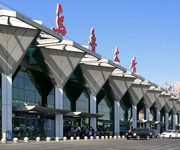
Ürümqi (/uːˈruːmtʃi/, literally "beautiful pasture", from Mongolian), is the capital of Xinjiang Uyghur Autonomous Region of the People's Republic of China in the northwest of the country. Urumqi was a major hub on the Silk Road during China's Tang dynasty, and developed its reputation as a leading cultural and commercial center during the Qing dynasty. With a built-up (or metro) population of 2,988,715 as of 2010 census (6 urban and suburban districts but Dabancheng not yet urbanized) and 3.03 million in 7 urban and suburban districts, Ürümqi is the largest city in China's western interior. Since the 1990s Ürümqi has developed economically and now serves as a regional transport node, cultural, and commercial centre.
 Immediate attention
Immediate attention